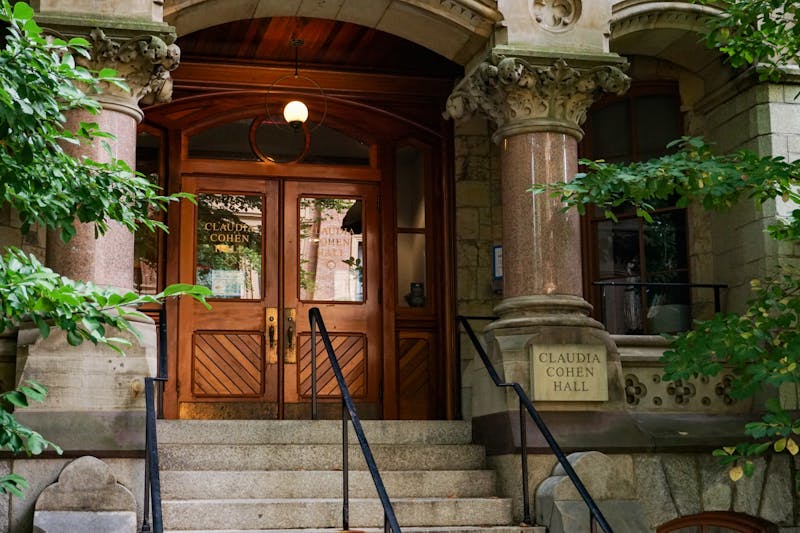The endless waits.
The lack of physicians.
The misdiagnoses.
These are the most common complaints students make about the quality of care offered at Student Health Service.
Each year, 13,000-plus students visit the office -- located on 34th Street opposite the Hospital of the University of Pennsylvania -- with everything from cold symptoms to pneumonia.
But although the University provides this service for its students, some leave the doctor's office disappointed with their treatment.
Chris, a College senior who asked that her last name be withheld, is one of those disgruntled patients. After spending a day dehydrated and throwing up, her roommate decided it was time for her to pay a visit to SHS.
From the beginning, the encounter, she said, did not go well.
"They told me that I had to wait and sit in the front office area even though [my roommate] had called and said it was an emergency," she said.
Feeling faint and naseous, she asked a nurse if there was someplace where she could lie down while she waited. A nurse escorted her to a room.
"She had me stand up to take my blood pressure," she said. "I told her I was going to pass out, and she just turned around, she put her back to me. Then I just went down. I passed out."
Stories like this spread across campus and give the service an unwarranted bad reputation, SHS Director Evelyn Wiener said.
"The negative rumor or the negative experience is the one that tends to get repeated and that becomes part of the folklore," she said.
On top of students' complaints about inadequate care, there are the waits.
In recent years, the number of people utilizing the walk-in system increased significantly. And as this number increased, so did the wait time.
In fact, last school year, about 36 percent of walk-in patients at student health had to wait for over a half an hour to be seen, and 10 percent of those students had to wait for over an hour, according to the SHS annual report.
"Over the past several years, more and more students would come to walk-ins, especially in the late afternoon," Wiener said. "As they did that, the waits would get longer and longer."
As a result, more providers were assigned to urgent care, which led to the removal of appointment slots.
In response to long waits and decreased appointment availability, SHS administrators have eliminated the walk-in system and replaced it with what they say is a more efficient system of same-day appointments.
"On just about any given day, when we start off the day, we have generally more than half of our appointment slots open and available for same-day appointments," Wiener said. "If you're willing to either call or... to come in, find out what's available and come back later in the day, you'll get seen."
Due to the change in the system, Wiener said the wait times have decreased significantly. But many people still have to wait more than 20 minutes, even with a scheduled same-day appointment.
Some speculate that this may be the result of a lack of physicians on staff. For the 13,000 students -- and 40,000 visits -- that Student Health Service says it deals with over the course of the average school year, there are 12 doctors on staff.
The lack of available doctors was a problem that College senior Stacey Beck said she experienced first hand.
After being afflicted with a bad sore throat, Beck went to SHS thinking she had strep throat. When she was finally seen -- after a 45-minute wait -- the physician examined her and said that she probably didn't have it. She was only given a rapid strep test after asking for one repeatedly.
"I had to basically beg them," she said.
When the test came back positive, Beck mentioned a family history of a penicillin allergy. But after the physician said he did not know of another treatment, only after suggesting amoxicillin herself did Beck receive the proper prescription.
Wiener claims that there is ongoing training for SHS staff members in order to avoid incidents such as these.
"We are charged with making sure that everybody's skills are up to par," she said.
But still, some say incidents of bad care continue to occur.
"I've never had a good experience there," Beck said. "They don't care about giving the students the services that they deserve and pay for."
And another College senior, who wished to remain anonymous, has had more than her share of problems with student health.
Last fall, the student experienced what she thought were typical flu symptoms. At the end of the first two weeks of the illness, there was no improvement in her health, so she paid a visit to SHS.
After describing her symptoms to one of the residents, she was diagnosed with walking pneumonia, but the doctor did not prescribe antibiotics.
Two days later, her condition had only worsened.
"At this point, I was coughing up not only phlegm, but phlegm with blood," she said.
She spent the remainder of that day hooked up to an IV at the office, and physicians began to suspect an upper respiratory infection. She was sent to HUP for a CAT scan.
Before the test, she was informed that the procedure needed to be done on a full stomach and she was presented with a large container of a thick white liquid and was instructed to drink it in its entirety.
Despite her protests, the doctors insisted that the procedure was necessary and told her that they would insert a tube through her nose to her stomach in order to get the liquid into her system.
"They started sticking the tube down my nose and down my throat, and at that point, I coughed this huge cough, and I let out this huge glob of blood... so much blood that the assistant doctor, his jaw just dropped," she said. "The student health doctor said, 'You just won a trip to the emergency room.'"
X-rays were taken in the emergency room, and she remained at HUP for the next five days. She was once again diagnosed with walking pneumonia and, this time, given antibiotics.
But the antibiotics were not effective, and she eventually returned home to Colombia and visited her regular doctor, who identified her illness and treated it immediately.
"It ended up being a deep pulmonary infection," she said. "It was diagnosed and [antibiotics were] prescribed in less than half an hour."
In an extreme case such as this one, the facts are reviewed by SHS administrators and an incident report is filed. But the key lies in reporting the incident.
Many students are not made aware of the feedback mechanisms for filing complaints. According to Wiener, there is information in the SHS office and on its Web site about how to file a complaint.
"I will make sure that we put a link... or a mechanism on our web page so that any student who is unhappy with their medical care or with their experiences here can communicate that with us," Wiener said. "I can't respond to a complaint if I don't know what it is."
Wiener said she believes the problem for SHS is not the lack of medical providers, but the lack of physical space.
"We've probably hit our limit on how efficient we can be in terms of getting people in and out of here as quickly as possible, simply because our physical plan doesn't allow it," Wiener said.
Whatever the concerns -- lack of space, doctors or knowledge -- Wiener does have positive words for the future.
"I would love for every single interaction between patient and provider to be the best it can be." Wiener said. "That's my goal."
The Daily Pennsylvanian is an independent, student-run newspaper. Please consider making a donation to support the coverage that shapes the University. Your generosity ensures a future of strong journalism at Penn.
DonatePlease note All comments are eligible for publication in The Daily Pennsylvanian.







